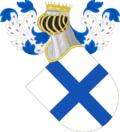Blanche of Portugal (1259–1321)
| Infanta Branca | |
|---|---|
| Lady of Huelgas, of Montenor, Campo-Mayor, Alcocer Lady of Las Huelgas de Burgos | |
 Infanta Branca of Portugal, in António de Holanda's Genealogy of the Royal Houses of Spain and Portugal (1534) | |
| Born | 25 February 1259 Guimarães, Kingdom of Portugal |
| Died | 17 April 1321 (aged 62) Burgos, Crown of Castile |
| Burial | Abbey of Santa María la Real de Las Huelgas, in Burgos, Castile |
| Issue |
|
| House | House of Burgundy |
| Father | Afonso III |
| Mother | Beatrice of Castile |
| Religion | Roman Catholicism |
Infanta Branca of Portugal (25 February 1259 in Guimarães – 17 April 1321 in Burgos; Portuguese pronunciation: [ˈbɾɐ̃kɐ]), Blanche in English and Blanca in Spanish, was a Portuguese infanta (princess), eldest daughter of King Afonso III and his second wife Beatrice of Castile. She was named after her great-aunt Blanche of Castile, queen of France.
Biographical sketch
Branca was born in Guimarães, Kingdom of Portugal, and moved to the Castile with her mother, Queen Beatrice,[1] due to differences with her brother King Denis of Portugal and there is documentary proof that mother and daughter lived in the city of Seville with King Alfonso X of Castile.[2]
In 1295, she became a nun at the Convent of Las Huelgas Huelgas, as evidenced by a letter dated 15 April 1295 detailing the reasons that led her to become a nun at the recommendation and instructions of her uncle King Sancho IV of Castile, even though at first she had been reluctant to enter the religious order.[2]

She brought to the convent her dowry which consisted of several villages and properties and in 1303 donated to the convent the salt mines at Poza de la Sal and at Añana. Called the lady and keeper of the convent, Blanche was never its abbess, since during that time, between 1296 and 1326, Las Huelgas was governed by abbess Urraca Alfonso.[2]
In 1303, upon her mother's death, Blanche inherited the señorío of Alcocer. On 27 September 1305, she purchased for 170,000 maravedíes from Juana Gómez de Manzanedo, the widow of infante Louis, son of Ferdinand III of Castile, her inheritance in the city of Briviesca.[3] She is considered the founder of the city as its sponsor and coordinator, and with the founding of the Colegiata de Santa María.[4] "Her work was not limited to the urban planning of the new city, the layout of its streets (...) she also granted it a legal instrument for its governance and administration, the Fuero of 1313, which was inspired by the text of the Royal Fuero".[5]
Will, death, and burial

She executed a will on 15 April 1321[6] where she ordered her burial at the Convent of Las Huelgas[7] and also asked that ten thousand masses were to be celebrated for the good of her soul. In her will, she granted the city of Briviesca to King Alfonso XI of Castile with the condition that the city was never to be a señorío, that the king was to pay her debts totalling 300,000 maravedís, and entrusted him with the protection of the city and of the Colegitata de Santa María la Mayor which she had founded. [8] Blanche named several executors of her will, including Queen María de Molina and Gonzalo de Hinojosa, the bishop of Burgos.[9]
Infanta Blanche died at the Convent on 17 April 1321.[10] Her sepulchre is decorated with intertwined stars and decorated with the arms of the kingdoms of Castile, León, and of the Kingdom of Portugal.[2]
Issue
She had a natural son by a Portuguese nobleman named Pedro Nunes Carpinteiro:[2]
- Juan Núñez de Prado, Master of the Order of Calatrava and vassal of King Alfonso XI of Castile and his son King Pedro of Castile, who had him killed in 1355 at the castle in Maqueda.[11]
Ancestry
| Family of Blanche of Portugal (1259–1321) | ||||||||||||||||||||||||||||||||||||||||||||||||||||||||||||||||||||||||||||||||||||||||||||||||||||||||||||||||||||||||||||||||||||||||||||||||||||||||||||||||||||||||||||||||||||||||||||||||||||||||||||||||||||||||||||||||||||||||||||||||||||||||||||||||||||||||||||||||||||||||||||||||||||||||||||||||||||||||||||||||||||||||||||||||||||||||||||||||||||||||||||||||||||||||||||||||||||||||||||||||||||||||||||||||||||||||||||||||||||||||||||||||||||||||||||||||||||||||||||||||||||||||||||||||||||||||||||||||||||||||||||||||||||||||||||||||||||||||||||||||||||||||||||||||||||||||||||||||
|---|---|---|---|---|---|---|---|---|---|---|---|---|---|---|---|---|---|---|---|---|---|---|---|---|---|---|---|---|---|---|---|---|---|---|---|---|---|---|---|---|---|---|---|---|---|---|---|---|---|---|---|---|---|---|---|---|---|---|---|---|---|---|---|---|---|---|---|---|---|---|---|---|---|---|---|---|---|---|---|---|---|---|---|---|---|---|---|---|---|---|---|---|---|---|---|---|---|---|---|---|---|---|---|---|---|---|---|---|---|---|---|---|---|---|---|---|---|---|---|---|---|---|---|---|---|---|---|---|---|---|---|---|---|---|---|---|---|---|---|---|---|---|---|---|---|---|---|---|---|---|---|---|---|---|---|---|---|---|---|---|---|---|---|---|---|---|---|---|---|---|---|---|---|---|---|---|---|---|---|---|---|---|---|---|---|---|---|---|---|---|---|---|---|---|---|---|---|---|---|---|---|---|---|---|---|---|---|---|---|---|---|---|---|---|---|---|---|---|---|---|---|---|---|---|---|---|---|---|---|---|---|---|---|---|---|---|---|---|---|---|---|---|---|---|---|---|---|---|---|---|---|---|---|---|---|---|---|---|---|---|---|---|---|---|---|---|---|---|---|---|---|---|---|---|---|---|---|---|---|---|---|---|---|---|---|---|---|---|---|---|---|---|---|---|---|---|---|---|---|---|---|---|---|---|---|---|---|---|---|---|---|---|---|---|---|---|---|---|---|---|---|---|---|---|---|---|---|---|---|---|---|---|---|---|---|---|---|---|---|---|---|---|---|---|---|---|---|---|---|---|---|---|---|---|---|---|---|---|---|---|---|---|---|---|---|---|---|---|---|---|---|---|---|---|---|---|---|---|---|---|---|---|---|---|---|---|---|---|---|---|---|---|---|---|---|---|---|---|---|---|---|---|---|---|---|---|---|---|---|---|---|---|---|---|---|---|---|---|---|---|---|---|---|---|---|---|---|---|---|---|---|---|---|---|---|---|---|---|---|---|---|---|---|---|---|---|---|---|---|---|---|---|---|---|---|---|---|---|---|---|---|---|---|---|---|---|---|---|---|---|---|---|---|---|---|---|---|---|---|---|---|---|---|---|---|---|---|---|---|---|---|---|---|---|---|---|---|---|---|---|---|---|---|---|---|---|---|---|---|---|---|---|---|---|---|---|---|---|---|---|---|---|---|---|---|---|---|---|---|---|---|---|---|---|---|---|---|---|---|---|---|---|---|---|---|---|---|---|---|---|---|---|---|---|---|---|---|---|---|---|---|---|---|---|---|---|---|---|---|---|---|---|---|---|---|---|---|---|---|---|---|---|---|---|---|---|---|---|---|---|---|---|
| ||||||||||||||||||||||||||||||||||||||||||||||||||||||||||||||||||||||||||||||||||||||||||||||||||||||||||||||||||||||||||||||||||||||||||||||||||||||||||||||||||||||||||||||||||||||||||||||||||||||||||||||||||||||||||||||||||||||||||||||||||||||||||||||||||||||||||||||||||||||||||||||||||||||||||||||||||||||||||||||||||||||||||||||||||||||||||||||||||||||||||||||||||||||||||||||||||||||||||||||||||||||||||||||||||||||||||||||||||||||||||||||||||||||||||||||||||||||||||||||||||||||||||||||||||||||||||||||||||||||||||||||||||||||||||||||||||||||||||||||||||||||||||||||||||||||||||||||||
References
- ^ García Fernández 1999, p. 909.
- ^ a b c d e Concejo Díez 2003, p. 314.
- ^ Ibarra Álvarez et al 1998, p. 328.
- ^ Ibarra Álvarez et al 1998, p. 329-337.
- ^ Ibarra Álvarez et al 1998, p. 337.
- ^ Ibarra Álvarez et al 1998, p. 330.
- ^ Castro Garrido 1987, p. 323-333, charter 364.
- ^ Castro Garrido 1987, p. 324-325.
- ^ Castro Garrido 1987, p. 325-326.
- ^ Arco y Garay 1954, p. 263.
- ^ Arco y Garay 1954, p. 261.
- ^ Salazar y Acha 1990, pp. 222–223.
- ^ a b Salazar y Acha 1990, p. 227.
- ^ a b c d Salazar y Acha 1990, p. 223.
- ^ Salazar y Acha 1989, p. 81.
Bibliography
- Arco y Garay, Ricardo del (1954). Sepulcros de la Casa Real de Castilla (in Spanish). Madrid: Instituto Jerónimo Zurita. Consejo Superior de Investigaciones Científicas. OCLC 11366237.
{{cite book}}: Invalid|ref=harv(help) - Castro Garrido, Araceli (1987). Documentación del Monasterio de Las Huelgas de Burgos (1307-1321) (in Spanish). Burgos: Ediciones J.M. Garrido Garrido. ISBN 84-86371-15-5.
{{cite book}}: Invalid|ref=harv(help) - Consejo Díez, María Luisa (1999). El arte mudejar en Burgos y su provincia, Tesis doctoral (PDF) (in Spanish). Madrid: Departamento de Historia del Arte (Medieval), Facultad de Geografía e Historia, Universidad Complutense de Madrid.
{{cite book}}: Invalid|ref=harv(help) - García Fernández, Manuel (1999). "La política internacional de Portugal y Castilla en el contexto peninsular del Tratado de Alcañices (1267-1297). Relaciones diplomáticas y dinásticas" (PDF). Revista da Faculdade de Letras, Serie Historia (in Spanish) (XV). Universidade de Porto: 901–943. OCLC 632487275.
{{cite journal}}: Invalid|ref=harv(help) - Ibarra Álvarez, José Luis; Ortega Martínez; Ana Isabel (1998). "La villa de Briviesca en la Baja Edad Media: datos y reflexiones para su estudio" (PDF). Boletín de la Institución Fernán González (in Spanish) (217): 321–352. ISSN 0211-8998.
{{cite journal}}: Invalid|ref=harv(help)

